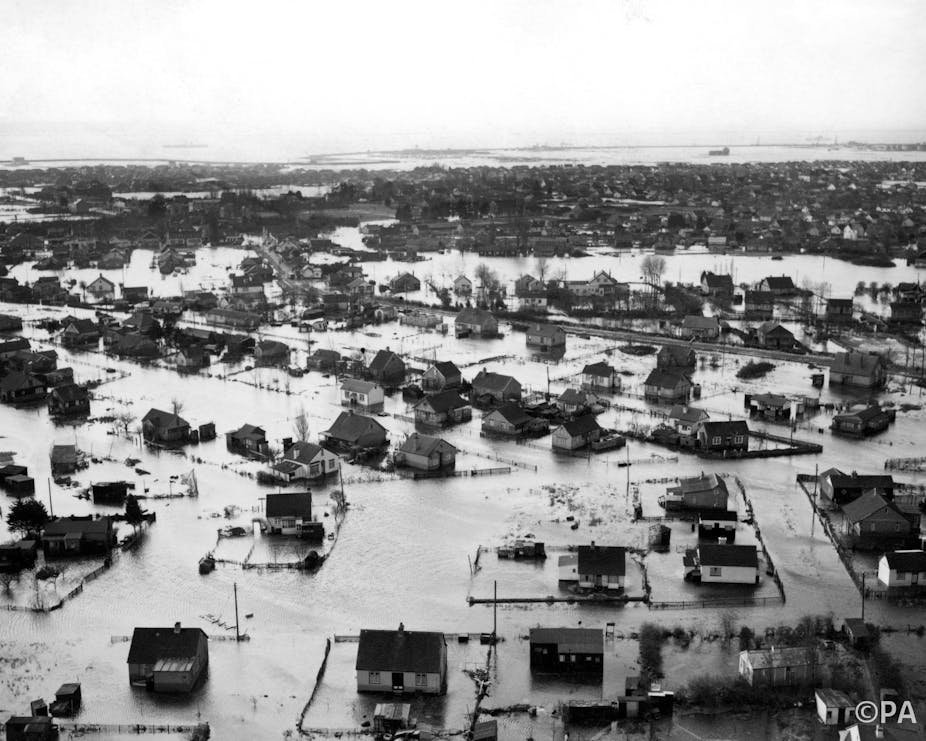Brigid, another Atlantic storm, has hit Britain with heavy rain and gale-force winds, especially the already sodden west coast. The last few months have seen very wild weather, including 100mph winds during October’s St Jude’s storm, heavy rain and flooding, and one of the highest ever storm surges off the east coast.
During these storm surges, large increases in sea level can last from a few hours to several days and span hundreds of square kilometres. Low atmospheric pressure allows the sea level to rise and, with the combination of gale force winds and the Earth’s rotation, water is forced towards the coastline.
The same physics apply whether they are caused by European weather systems (known as extra-tropical cyclones) or those in the tropics (hurricanes). Sea levels during a storm surge can rise by up to 8m in tropical areas, and by more than 3m in the North Sea. A combination of high tide, storm surge, wind and wave conditions can overtop or breach coastal defences, and it is often the storm surge that provides the additional power that drives waves to destructive levels.
Worldwide, storm surges cause significant damage and loss of life. For example, in 1970 a devastating surge during the Bhola cyclone killed perhaps 300,000 people in Bangladesh, and in more recent years Hurricane Katrina and Superstorm Sandy in the US have demonstrated their power.
Coastal flooding
Coastal flooding around the UK can be life-threatening in addition to wreaking economic and environmental destruction. The worst in modern times was the North Sea floods of 1953. Huge waves breached flood defences, and coastal towns in Lincolnshire, Norfolk, Suffolk, Essex and Kent were devastated as seawater rushed into the streets. In the Netherlands 1,800 people were killed while in England and Scotland the toll was 326, and over 600km2 were flooded.
An inquiry found that along the 1,600 km of coast affected there were 1,200 breaches, at an estimated cost of £40-£50m – around £1 billion at today’s prices. Today, assets worth £150 billion and 4m people are at risk from coastal flooding in Britain. Analysis by the Environment Agency shows that some 500,000 homes are at risk of flooding in the Thames floodplain.

Battered island
The sequence of storms that battered Britain in December and January were some of the most severe we’ve seen in recent years. During the 5th and 6th December, measured sea levels in parts of the North Sea were the highest since the 1953 floods, and the Thames Barrier and Dutch flood barriers were closed for several tides.
The largest storm surges struck the northeast coast of England, from Tyneside to Norfolk. Around 400 homes were flooded near Hull, and about 10,000 homes were evacuated in Norfolk and Suffolk. The fact the damage was so limited compared to the tragedy of 1953 is thanks to significant government investments in coastal defences, flood forecasting and sea level monitoring. The UK now has a sophisticated network of 42 coastal tide gauges for flood forecasting.

Unfortunately there is little data from 1953 which makes a direct comparison difficult. Water levels at North Shields in December 2013 were 4m, 0.5m higher than in 1953, and the 2013 levels at the Hull Barrier were at 5.8m - the highest ever recorded there. Conversely, water levels in 2013 at Harwich and Sheerness in the Thames estuary were 4.1m, about 0.5m lower than in 1953.
While a detailed scientific analysis of the event will take place over the coming months, the emerging picture is of a storm surge very similar to that of 1953 but which struck with greater force in the north of England, which is explained by the 2013 storm’s more northerly trajectory. Those who study Britain’s never-dull weather know that no two storms are identical, which is why complex statistical methods have been devised to gauge water levels around the coast.
Staying ahead of the deluge
The coastal flood warning system, UK Coastal Monitoring and Forecasting (UKCMF), is a partnership of agencies monitoring wind, wave, tides and weather conditions. It combines computer models of storm surges and waves with real-time monitoring of coastal sea levels, all interpreted by a team of expert forecasters working around the clock.
The numerical models are subject to continuous improvement as more powerful computers and new scientific insight becomes available. The whole system depends on accurate weather prediction, and it is because of better forecasting that it was possible to provide warnings for the December 2013 storm days in advance. The system also makes use of a technique called ensemble forecasting to quantify the inherent uncertainty in short-term weather prediction. The weather model is run several times, adjusting conditions and parameters to provide a range of outcomes that can then be used to judge the reliability of the forecast.
Any increase in the frequency or severity of flooding would have a serious impact on the economy, society and ecosystems. In global studies based on tide gauge data, trends in extreme sea level have been shown to be controlled by changes to mean sea level rather than changes in storminess. For the UK there is no observational evidence of long-term trends in storm surges.

For the time being we should assume that changes to flood water levels will be governed by a rise in the mean sea level. And while the jury is out on changes to mid-latitude storminess in the future, the Intergovernmental Panel on Climate Change is unequivocal in its assessment of the gradual rise in mean sea level: the projected rise in globally averaged sea level for the year 2100 is in the range 0.29-0.82m, depending on greenhouse gas emissions.
Even if there is no change to the storm climate of northern Europe, this rise in sea level is bound to increase the frequency of high water levels, and so the chances of flooding. Investment in weather prediction, flood warning mechanisms and coastal defences must not be neglected.

